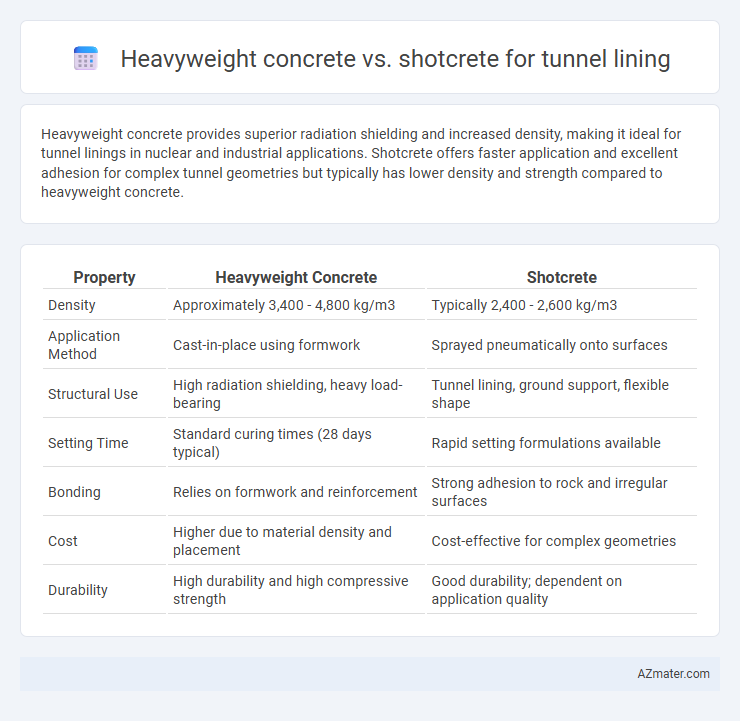Heavyweight concrete provides superior radiation shielding and increased density, making it ideal for tunnel linings in nuclear and industrial applications. Shotcrete offers faster application and excellent adhesion for complex tunnel geometries but typically has lower density and strength compared to heavyweight concrete.
Table of Comparison
| Property | Heavyweight Concrete | Shotcrete |
|---|---|---|
| Density | Approximately 3,400 - 4,800 kg/m3 | Typically 2,400 - 2,600 kg/m3 |
| Application Method | Cast-in-place using formwork | Sprayed pneumatically onto surfaces |
| Structural Use | High radiation shielding, heavy load-bearing | Tunnel lining, ground support, flexible shape |
| Setting Time | Standard curing times (28 days typical) | Rapid setting formulations available |
| Bonding | Relies on formwork and reinforcement | Strong adhesion to rock and irregular surfaces |
| Cost | Higher due to material density and placement | Cost-effective for complex geometries |
| Durability | High durability and high compressive strength | Good durability; dependent on application quality |
Introduction to Tunnel Lining Methods
Heavyweight concrete and shotcrete are both essential materials in tunnel lining, offering distinct benefits based on structural requirements and site conditions. Heavyweight concrete provides enhanced radiation shielding and durability for tunnels with heavy load demands, while shotcrete enables rapid application and superior adhesion on irregular surfaces, improving construction efficiency. Selection depends on factors like load-bearing capacity, environmental exposure, and project timelines to ensure optimal tunnel stability and safety.
Overview of Heavyweight Concrete
Heavyweight concrete is a dense, high-mass material formulated with heavyweight aggregates such as magnetite, hematite, or barite, achieving densities typically between 3200 to 3700 kg/m3, which provides superior radiation shielding and structural stability in tunnel linings. Its high density significantly reduces radiation penetration and vibration transmission, making it essential in tunnels requiring enhanced protection against nuclear, medical, or high-energy applications. The material's mechanical strength, durability, and resistance to chemical attacks enable long-lasting tunnel support under harsh environmental conditions, distinguishing it from shotcrete, which is generally lighter and often used for spray-applied, temporary or initial lining purposes.
Overview of Shotcrete Technique
Shotcrete involves pneumatically projecting concrete onto tunnel surfaces at high velocity, enabling rapid application and excellent adhesion to complex geometries. This technique offers superior versatility for tunneling projects, providing effective reinforcement and support without extensive formwork compared to heavyweight concrete cast in place. The accelerated curing and reduced labor requirements of shotcrete make it a cost-efficient choice for stabilizing tunnel linings in variable ground conditions.
Material Composition and Properties
Heavyweight concrete for tunnel lining incorporates heavyweight aggregates such as magnetite, barite, or hematite, increasing density to 3200-4000 kg/m3 and enhancing radiation shielding and structural mass. Shotcrete, a pneumatically applied concrete mix, uses similar binder materials but features a high cement content and admixtures for improved sprayability, rapid setting, and adhesion to irregular tunnel surfaces. The differences in water-to-cement ratio, aggregate size, and fiber reinforcement in shotcrete optimize its toughness and shrinkage resistance, contrasting with heavyweight concrete's emphasis on compressive strength and density.
Installation Process Comparison
Heavyweight concrete installation for tunnel lining typically involves traditional casting methods requiring extensive formwork, careful batching, and longer curing times to handle the dense aggregates, which can impact construction speed. Shotcrete application enables faster placement with pneumatic spraying directly onto the tunnel surface, reducing formwork needs and allowing for immediate setting, making it highly suitable for complex geometries and rapid stabilization. The shotcrete process also demands skilled operators to control nozzle distance and pressure, ensuring optimal layer thickness and bonding, whereas heavyweight concrete relies more on precise mixing and placement techniques to achieve structural integrity.
Structural Performance and Durability
Heavyweight concrete offers superior structural performance in tunnel lining due to its high density, enhancing load-bearing capacity and radiation shielding, making it ideal for nuclear or deep underground tunnels. Shotcrete provides excellent durability and bonding strength through its sprayed application, allowing rapid curing and adaptability to complex tunnel geometries, which reduces cracking and water ingress. Both materials enhance structural integrity, but heavyweight concrete excels in high-stress environments, while shotcrete optimizes durability in challenging construction conditions.
Cost Analysis and Economic Considerations
Heavyweight concrete generally incurs higher material costs due to the inclusion of dense aggregates like barite or magnetite, increasing its overall price compared to shotcrete. Shotcrete offers economic advantages with lower labor costs and faster application, reducing project timelines and associated expenses in tunnel lining projects. Cost analysis must consider long-term durability and maintenance, where heavyweight concrete may justify initial investment through enhanced shielding and structural integrity in specific tunnel applications.
Safety and Environmental Impact
Heavyweight concrete offers superior radiation shielding properties, enhancing tunnel safety in environments with radiation exposure, while shotcrete provides rapid application and high early strength, reducing construction time and onsite hazards. Environmentally, heavyweight concrete has a higher embodied energy due to dense aggregate use, whereas shotcrete minimizes waste and energy consumption through efficient spraying techniques and reduced formwork requirements. Both materials require proper handling protocols to ensure worker safety, but shotcrete's spray application may pose inhalation risks without adequate protective measures.
Suitability for Different Tunnel Conditions
Heavyweight concrete offers exceptional density and radiation shielding, making it ideal for tunnels requiring enhanced structural strength and protection, such as nuclear waste repositories and high-radiation environments. Shotcrete provides superior adaptability to irregular tunnel surfaces and faster application, suited for complex geological conditions and emergency stabilization during tunnel excavation. The choice between heavyweight concrete and shotcrete depends on specific tunnel requirements including load-bearing capacity, environmental exposure, and construction speed.
Conclusion and Recommendations
Heavyweight concrete provides superior radiation shielding and structural strength ideal for nuclear tunnel linings, while shotcrete offers faster application and better adaptability to irregular tunnel geometries. For projects demanding enhanced protection from gamma radiation, heavyweight concrete is recommended, but shotcrete is preferable where rapid placement and flexibility are priorities. Combining shotcrete with heavyweight concrete layers can optimize both durability and construction efficiency in tunnel lining applications.

Infographic: Heavyweight concrete vs Shotcrete for Tunnel lining
 azmater.com
azmater.com